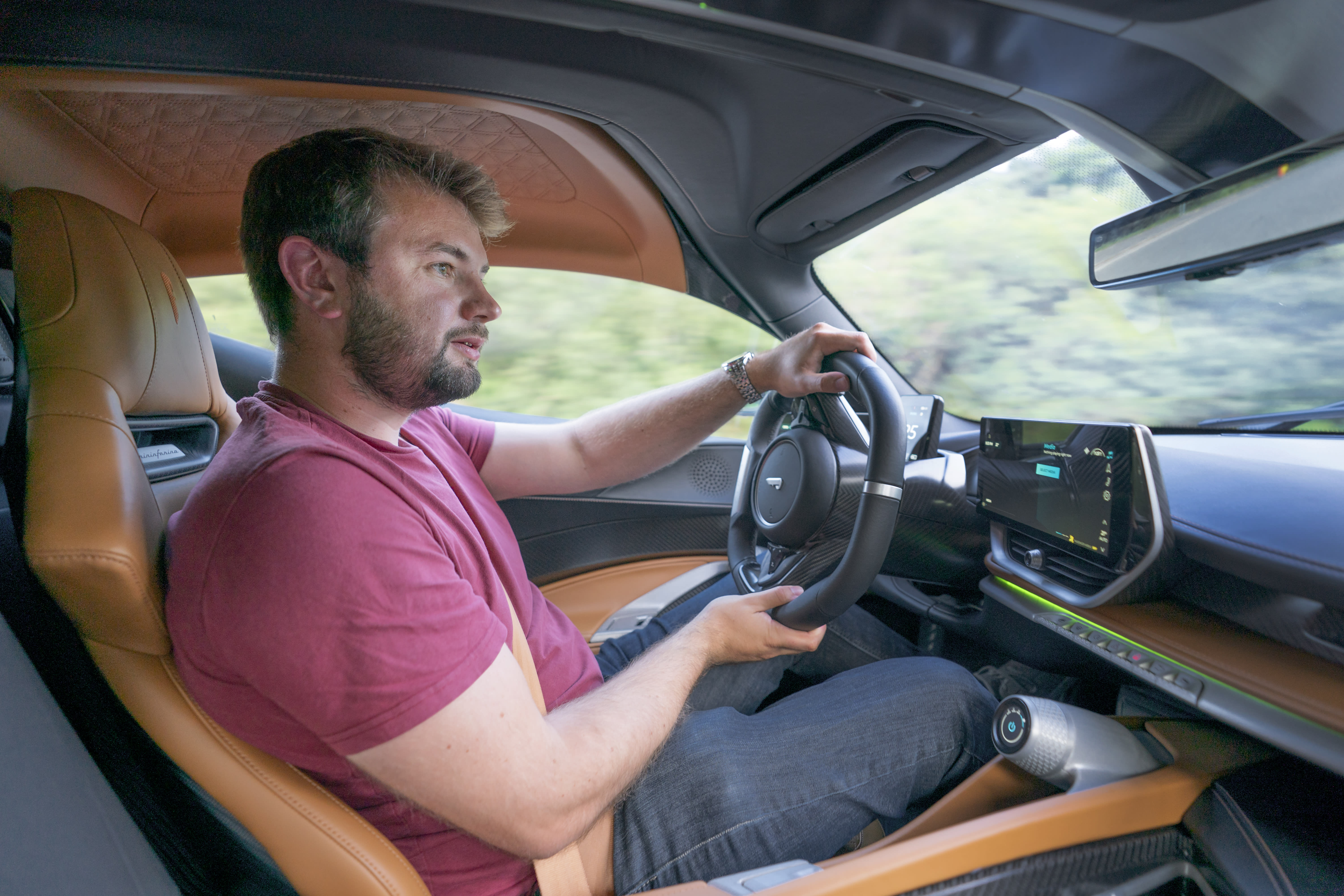
Porsche Panamera saloon (2024-) Review

Introduction
The Porsche Panamera didn’t have the easiest start to life. Although it has always been a technological masterpiece, Porsche took a while to get the car’s styling right. But fast-forward 15 years and the Panamera is a much more attractive beast that sits easily at the top of its class. And now there’s a new one, promising more efficiency, better ride comfort and better tech, as well as a minor styling upgrade.
We may not be talking about Dr Who levels of regeneration here – the Panamera hasn’t changed beyond all recognition – but Porsche has made considered tweaks to its flagship, giving it new infotainment and suspension technology, as well as making massive changes to the plug-in hybrid versions.
You can also (for the time being, at least) lease the Porsche Panamera as a more practical 'Sport Turismo' estate.
The question is, will all that be enough for the Panamera to fend off the challenge posed by the industry’s other powerful four-door grand tourers?
Select's rating score* - 4.1 / 5
At a Glance
It isn’t immediately easy to spot the differences between the outgoing and incoming versions of the Panamera, but that’s no bad thing. The old car still looks great, but the new model gets fresh bumpers, a slightly revamped window line and a modified nose, while high-performance Turbo and Turbo E-Hybrid versions get grey accents on the badges and trim.
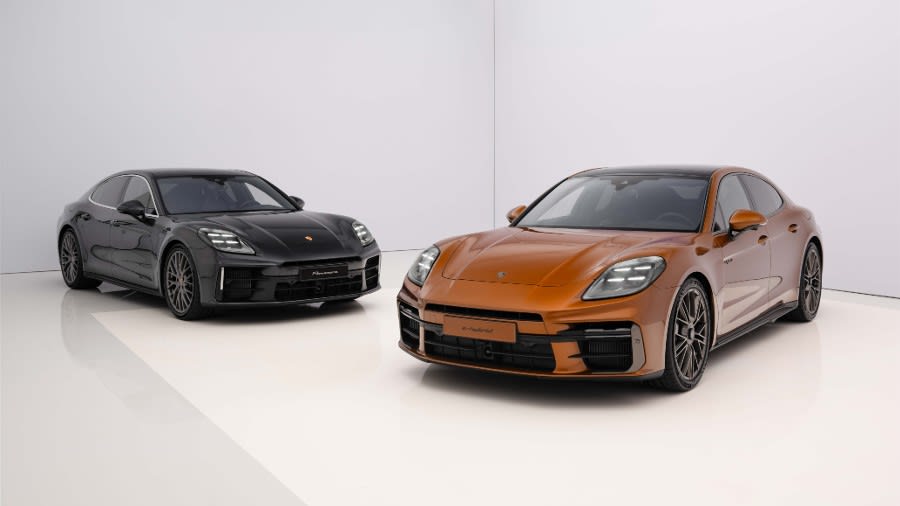
Inside, changes are more pronounced, with a classy cabin that now gets a fully digital instrument cluster taken from the Taycan electric car and a reworked centre console with a big climate control panel. Customers can also choose to supplement the sizeable central infotainment touchscreen with a secondary passenger display. It’s invisible from the driver’s side for safety reasons, but it allows the front-seat passenger to watch videos and use other media without distracting the driver.
But while Porsche has made some changes, the Panamera remains well made, sporty and spacious, with ample space for four adults to sit in comfort.
As before, a range of petrol and plug-in hybrid powertrains are available, and all will offer plenty of power. But though the petrol engines aren’t so different, the plug-in hybrids have changed noticeably. With more powerful electric motors and bigger batteries than before, they’re more useful and provide a greater reduction in fuel consumption and CO2 emissions.
Similarly, Porsche has retained the Panamera’s impressive handling and comfort despite changes to the suspension. The car rides smoothly, albeit with a bit of feel for what the wheels are up to, and the steering is spectacular. With great body control and feel through the controls, it has some of Porsche’s sporting DNA, as well as a luxurious feel.
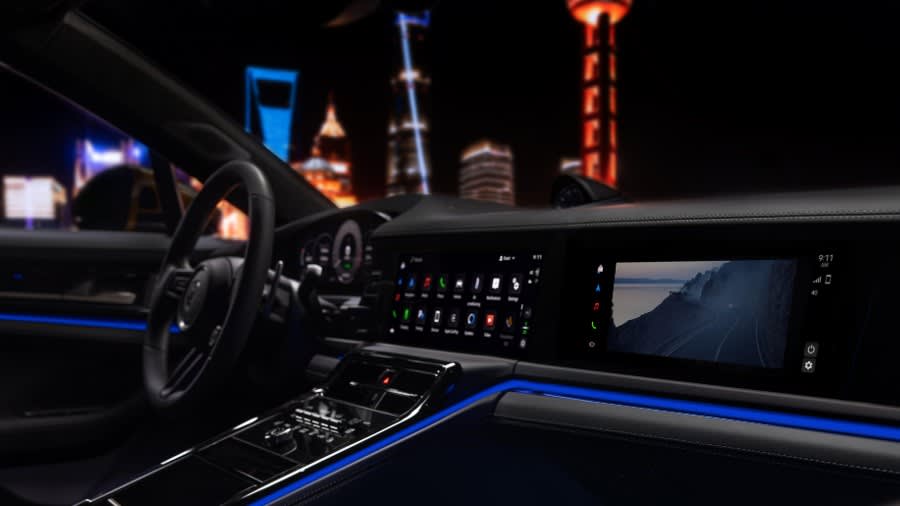
Key Features
Being a Porsche, the Panamera’s ride and handling are naturally prime considerations for a large proportion of customers, but the car offers much more than that. The updated model, in particular, now provides more in-car technology than its predecessors, including the new digital instrument display. Shared with the Taycan electric saloon and the Cayenne SUV, the system provides a clear and configurable display for drivers.
For passengers, meanwhile, the optional front passenger display will allow those in the left-hand front seat to access lots of vehicle information and media settings without disturbing the central screen. In fact, the system will even allow video playback on the move, thanks to a film in the screen that prevents the driver from being distracted by a view of what’s on the display.
But the tech isn’t just in the cabin. Porsche has also increased the battery size of plug-in hybrid models, and given them a more powerful electric motor to supplement their petrol engines. That means the electric motor doesn’t need so much help from the engine to provide the performance required, and it can deliver that performance for longer. As a result, the E-Hybrid versions of the Panamera are more efficient and more user-friendly than their predecessors.
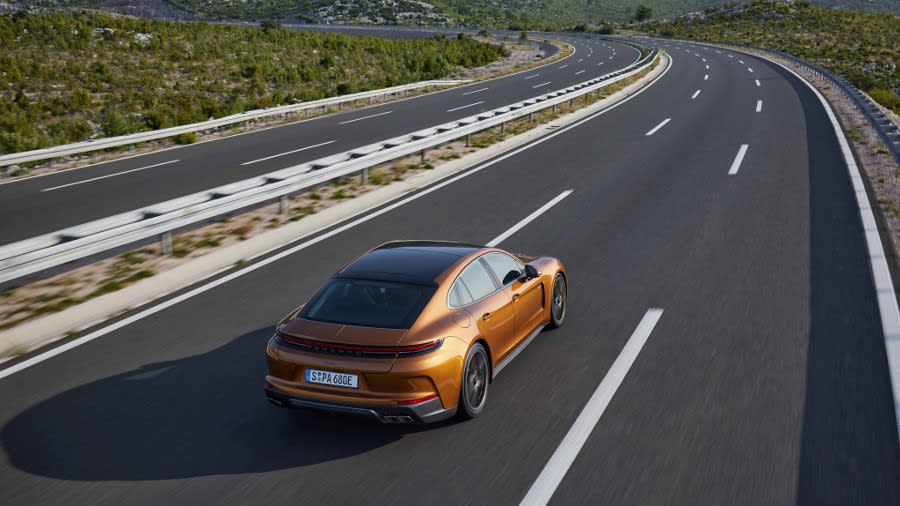
Range & Batteries
If we’re honest, the outgoing Panamera E-Hybrid models’ plug-in hybrid system was little more than a tax dodge that just so happened to be an efficient way of upping the power output. A fairly low zero-emission range meant it wasn’t that great for reducing consumption or emissions, and a mere 136hp prevented the Panamera from being too rapid in electric mode.
But as part of the Panamera’s update, Porsche has taken the old hybrid system and more or less done away with it. Now, plug-in hybrid versions of the Panamera (petrol versions will remain on offer) get a bigger 25.9kWh battery and a more powerful 190hp electric motor, making them more efficient and more useful. Not only will they go much further on a charge – up to 57 miles, according to the official economy test – but they also get better economy, lower emissions and less need to use the petrol engine to boost performance. It’s a win-win.
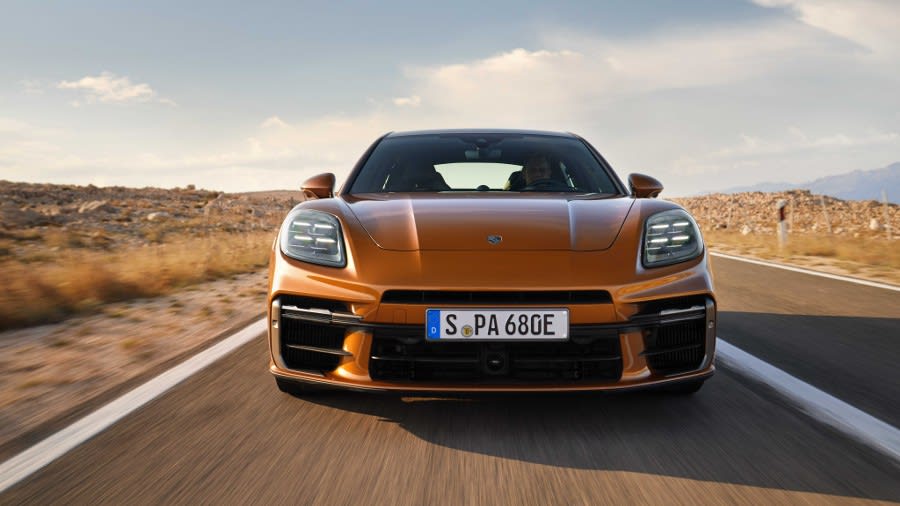
Performance & Drive
Porsche is still yet to unveil the full engine line-up for the new Panamera, but the range is pretty sizeable. What we do know is the range will start with the 2.9-litre V6 petrol-powered Panamera, which sends its 353hp to the rear wheels via an eight-speed automatic gearbox. That allows it to get from 0-62mph in about five seconds, before it races on to a top speed of 169mph. In short, it’s hardly slow, but every other model in the range is set to be faster. Take, for example, the next rung on the ladder: the Panamera 4. As the name suggests, it’s an all-wheel-drive version of the Panamera, but that extra traction enables it to set off slightly more quickly, cutting the 0-62mph time by a tenth of a second or so.
From there, Porsche is set to add S versions of the Panamera with more power and all-wheel drive, as well as E-Hybrids that use a revamped plug-in hybrid system in conjunction with that 2.9-litre petrol engine. For those models, Porsche has grown the battery to 25.9kWh, giving the car an electric-only range of up to 57 miles, and the electric motor now has 190hp, meaning it can be used more without the help of the petrol engine. That’s good for efficiency and emissions, as well as total power output. Expect to see the E-Hybrid suffix appended to Panamera 4 and Panamera 4S models.
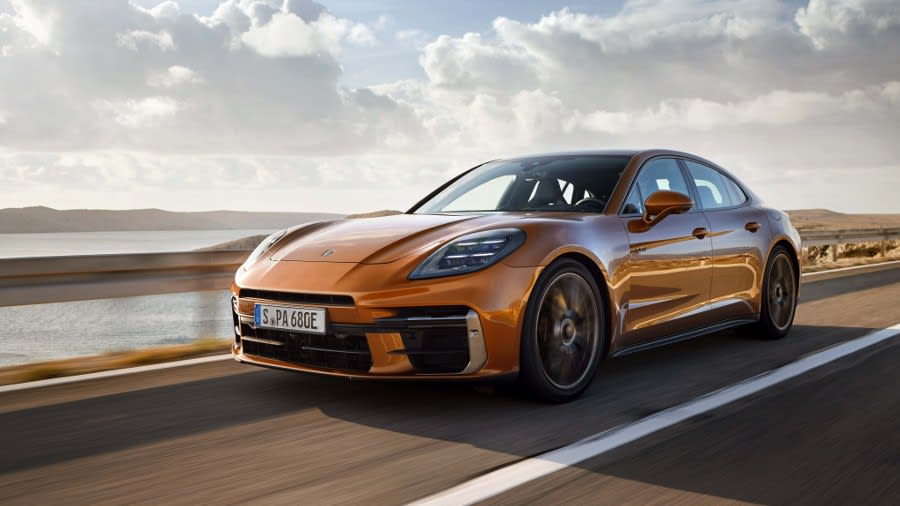
And just when you thought the range was big and powerful enough, there are also the V8s to consider. Using 4.0-litre, twin-turbocharged V8 engines, these models will offer various power outputs, depending on how far up the range you climb, but one of the more potent versions (although not the most potent model) will be the Turbo E-Hybrid. That will combine the V8 engine with the V6’s plug-in hybrid system to provide 680hp and all-wheel drive, taking the car from 0-62mph in 3.2 seconds before it hits its 196mph top speed. And the Turbo S E-Hybrid will be even faster, although all the V8 models will make a fabulous noise.
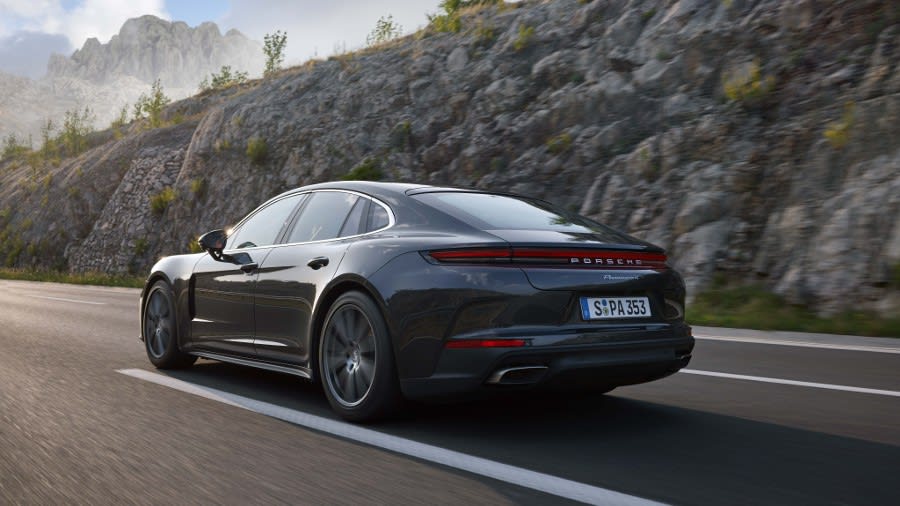
Performance, therefore, is well and truly taken care of, but Porsche has also worked on the Panamera’s comfort and handling. The air suspension has been reworked for maximum comfort, while there’s an optional active suspension system that can lean into corners and even jack up the car’s front or rear to mitigate the ‘rearing’ effect of acceleration or the ‘diving’ effect of braking. In truth, the system doesn’t feel all that natural – particularly under braking and acceleration – but it works in corners and it can always be switched off using the driving modes.
More importantly, the changes haven’t damaged the Panamera’s stunning comfort. Despite the precise steering and the immense agility, the car is supremely comfortable, and though it doesn’t quite glide over the bumps, it does round off the edges superbly, allowing you to feel what the tyres are doing without ever being rocked or juddered. It’s sublime.
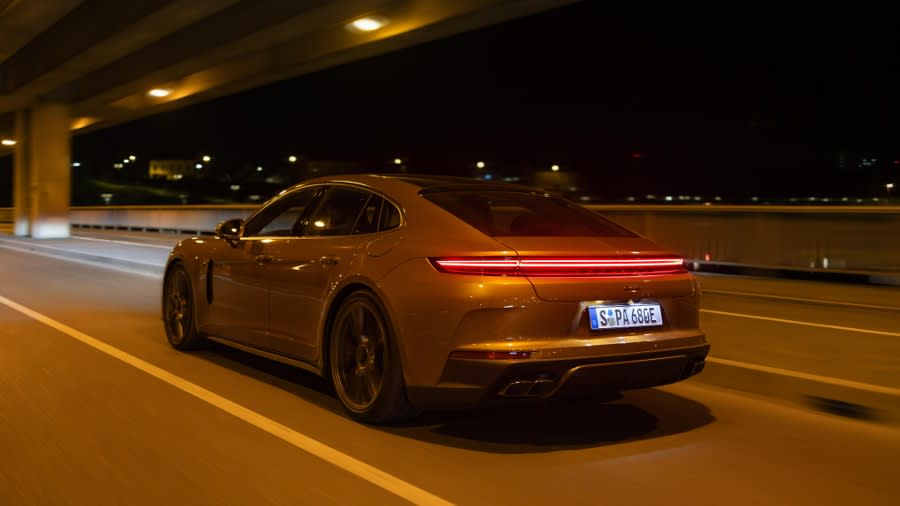
Charging
Because the new Panamera’s battery is bigger than that of its predecessor, it will take a little longer to charge if you use a three-pin plug (not recommended) or a domestic ‘wallbox’ electric vehicle charging point. However, Porsche has fitted the new model with an 11kW on-board charging system, which means the car can take power from so-called ‘three-phase’ commercial electricity supplies. That means you can up the charge power from 7kW to 11kW (assuming your supply is up to the job), and fill the battery in a little over two-and-a-half hours. It won’t suit every situation, but for charging overnight at hotels or for a few hours at a golf club, it’s perfect.
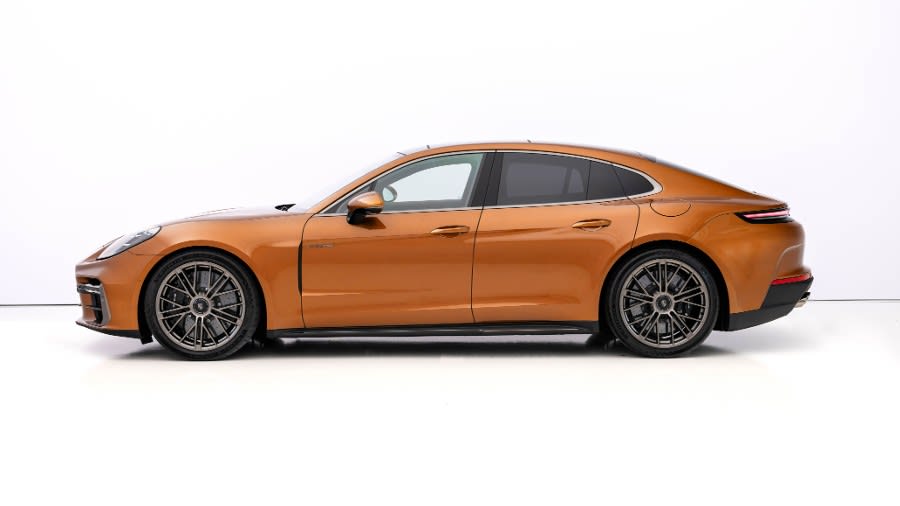
Running Costs & Emissions
Naturally, the cost of running a new-shape Panamera will depend largely on which version you choose. Those who go for one of the ‘conventional’ V8 petrol-powered variants will find their bank balances diminished significantly by fuel bills, while those who choose one of the updated plug-in hybrids might be pleasantly surprised.
With greater range and more power from the electrical propulsion systems, the E-Hybrid versions of the Panamera – whether V6- or V8-powered – are capable of spending more time with the petrol engine switched off. Whereas the old car could only manage perhaps 20 or so miles before the engine was required, the new model should do 40 miles without too much trouble. So commuting, the school run and shopping trips can all (at least in theory) be done on electric power alone. Of course, that depends on whether you can charge regularly, but if you can, and your lifestyle suits the system, you could find yourself with incredibly low fuel bills.
But the Panamera is a long-distance cruiser, and the hybrid system’s real advantage is reserved for company car drivers. While those with petrol-powered Panameras will see their Benefit-in-Kind tax bills hit extraordinary numbers, Panamera E-Hybrids have low official emissions that keep tax in check. For those driving company-funded wheels, it’s the obvious choice.
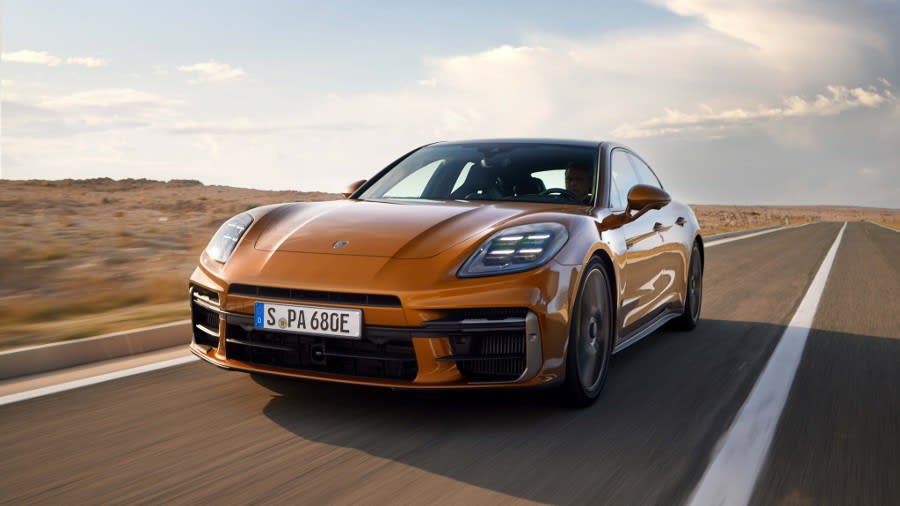
Interior & Technology
Porsche’s interiors have something of a reputation for being well-made but bland, and though the new Panamera ticks one of those boxes, we’re not so sure about the other. As before, the cabin is beautifully built, with lots of high-quality materials that are stitched together impeccably, but Porsche has changed the design quite noticeably.
Chief among the updates is the inclusion of a new digital instrument display that replaces the old combination of dials and screens. In truth, we’re a little sad to see the old cluster go – it was beautifully made and designed – but the new system is undoubtedly more modern and more configurable, with a crystal clear display. And it can be complemented by an equally sharp head-up display that helps you to keep your eyes on the road for more of the time.
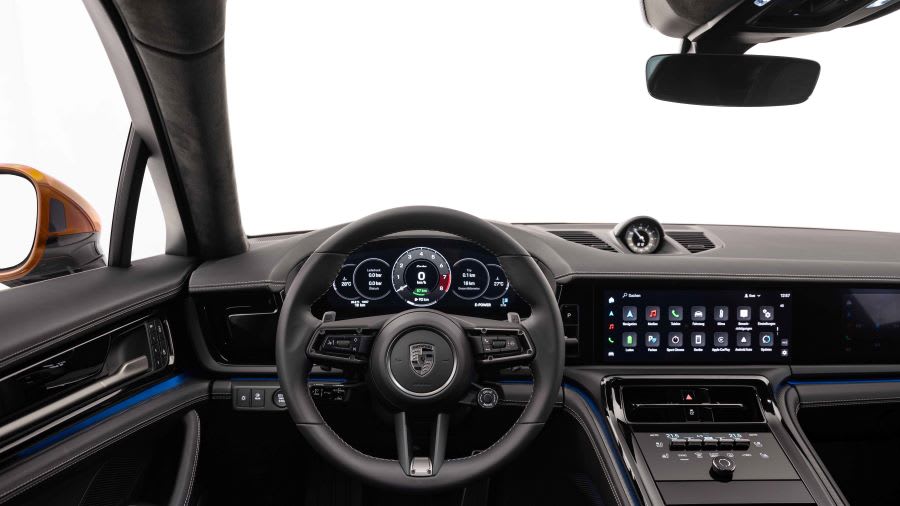
But the system, stolen from the Taycan electric model, has allowed Porsche to put a new toggle-style gear selector (also pinched from the Taycan) on the dashboard. That, in turn, has freed up some space on the centre console, which Porsche has used to house a new climate control panel. Easy to understand, and crucially fitted with proper switchgear, rather than touch-sensitive panels, it’s an easy system to use.
The same can also be said of the Panamera’s big central touchscreen, which isn’t the most exciting system on the market, but it is intuitive and easy to navigate, which counts for a lot. It also comes with all the features you normally need – a reversing camera, satellite navigation and the Apple CarPlay and Android Auto smartphone integration systems – plus access to the driving mode technology and the settings for the clever air suspension (where fitted).
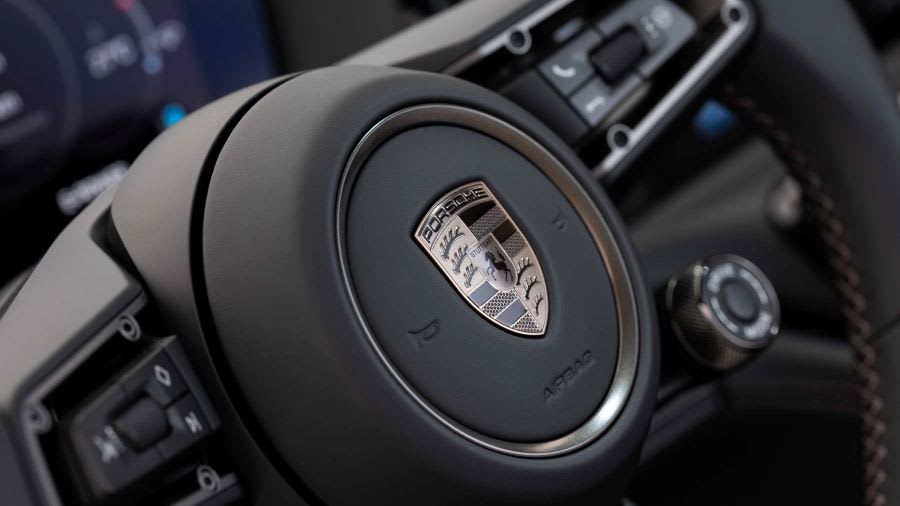
And Porsche is offering a similar screen, albeit without some of the functionality, as an optional extra for the passenger. Built into the dashboard panel in front of the right-hand front seat, the system allows passengers to access media and infotainment settings without troubling the central display upon which the driver may be relying. But it also allows passengers to stream video into the car on longer journeys without the driver being able to see. That’s thanks to a built-in film that makes the screen more or less invisible to the driver, allowing Porsche to avoid regulatory issues and distracting the driver. However, the film in the screen does make the colours look a bit funny from anything other than dead straight on, and that spoils things slightly.
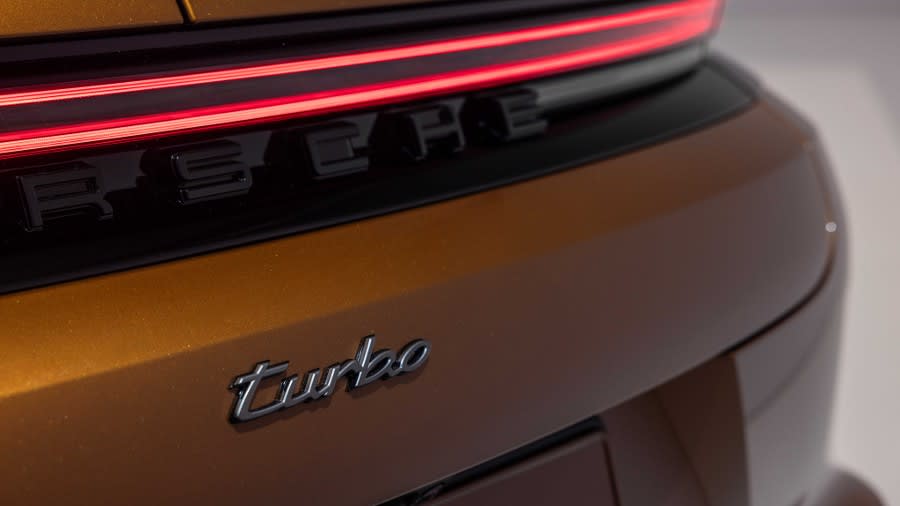
Practicality & Boot Space
The Panamera is built to be a sports car with saloon car space, and Porsche has more or less achieved that. Sure, the 421-litre boot is only around the same size as that of a BMW 4 Series Coupe, but it’s big enough for most eventualities. Especially as folding the rear seats and filling the car to the rafters provides more than 1,250 litres of total cargo capacity. It’s plenty for day-to-day use, and creative packing should allow the car to carry a family’s luggage to the airport. And, of course, those who want more cargo room can always opt for the slightly more spacious Sport Turismo model, which is effectively an estate version.
Whether you choose the saloon or the estate, however, rear passenger space is much more impressive than the luggage space. With ample room for four adults to sit in comfort, the Panamera manages to feel sporty and roomy all at the same time, with lots of legroom and sufficient headroom in the saloon. For those who regularly carry adults in the back, though, the estate might be a better bet, thanks to its fractional increase in rear headroom.
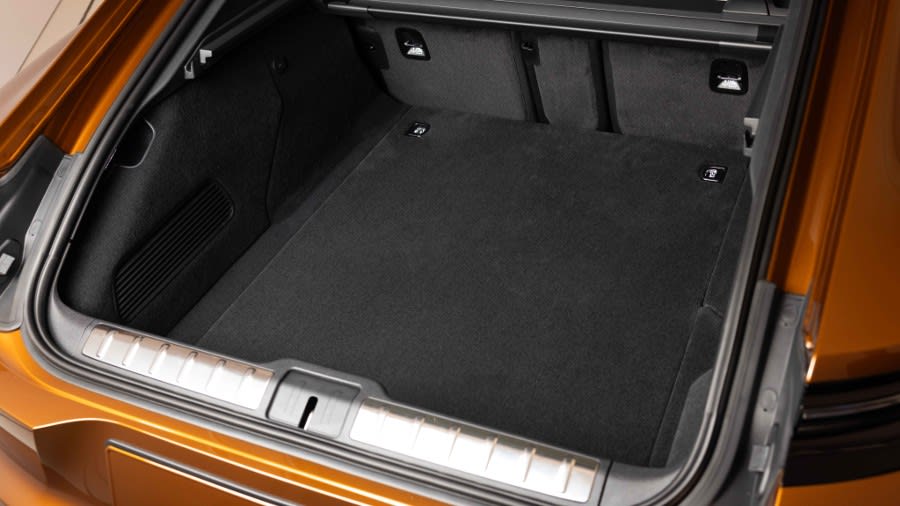
Safety
Euro NCAP has never crash-tested a Panamera of any generation, so we don’t know exactly how the big saloon would perform in the lab. However, we do know that every Porsche that has been tested by the independent European vehicle safety body received a five-star rating – the best score possible – so it seems likely that the latest-generation Panamera would follow suit.
Certainly, it comes with plenty of safety features. Cruise control, parking sensors, reversing cameras and the like are all included, as are the things you hope you never need – airbags, seatbelt pretensioners and all that jazz. But the Panamera also gets clever systems such as autonomous emergency braking that will slow or even stop the car if the driver doesn’t respond to a hazard, thus mitigating the effects of a crash. And there are features such as blind-spot monitoring and lane departure warning to prevent careless knocks. There’s a head-up display on offer, too, allowing drivers to spend more time with their eyes on the road, rather than in the cabin.
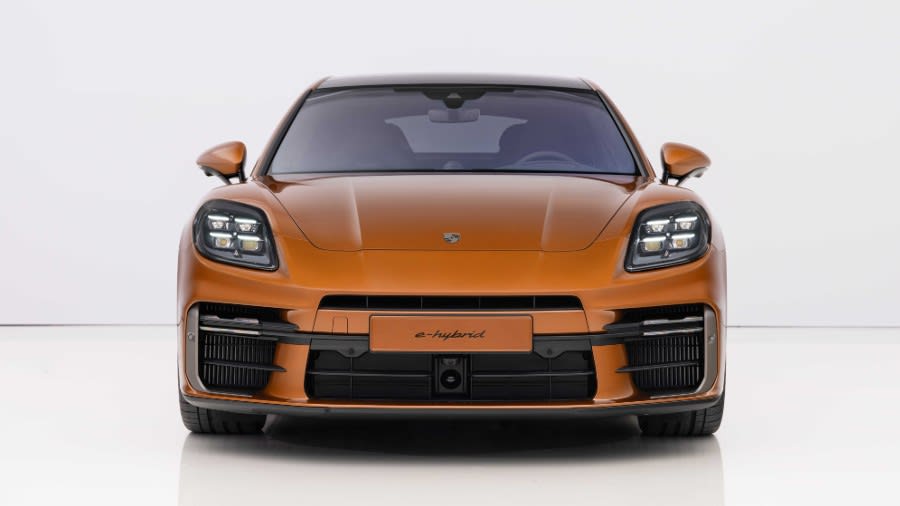
Options
Porsche hasn’t finalised the range for the new Panamera yet – at the time of writing, just three variants are on sale, but more are certainly on the way – so it’s difficult to sum up the range perfectly. What we do know is that the base model will simply be known as the Panamera, but it’ll still come with plenty of desirable standard features. Leather interior, satellite navigation and the digital instrument cluster will all be standard, along with climate control, heated front seats and a reversing camera. Parking sensors are in there, too, along with paddle-shifters for the gearbox.
As is the norm with Porsche models, moving up the range won’t provide all that much extra equipment, but rather a selection of options, most of which will also be offered on the standard car. However, Turbo versions of the Panamera – by which we mean anything that wears the Turbo badge, be it in conjunction with suffixes or not – will be marked out by their monochrome badges and grey exterior accent trim.
All-wheel-drive versions, sporty GTS models and various Turbo variants are expected, with a choice of E-Hybrid versions, too.
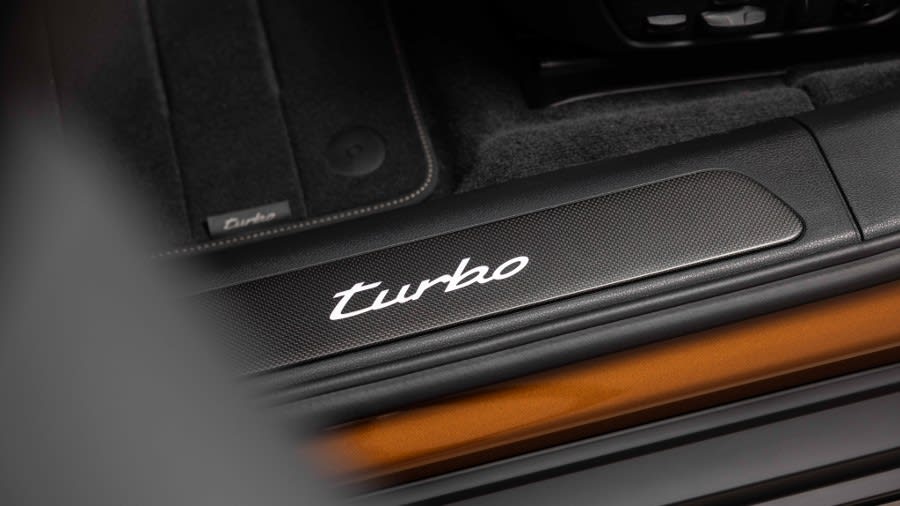
Rival Cars
As before, the Panamera might be one of the best in the business, but that doesn’t mean its free from capable rivals. Among its closest competitors is the Mercedes-AMG GT 4-Door, which offers ample style and speed, but lacks the Porsche’s cabin quality, and the Maserati Quattroporte, about which you could say much the same thing, albeit to a greater extent.
.jpg)
Other options include the Audi S8, which is a bit more of a limousine than the Panamera, but has some of the performance and comparable cabin quality, as well as a little more interior space. Similarly, there’s the BMW 8 Series Gran Coupe, which isn’t the prettiest thing on the road, but is great to drive, and there’s the Audi A7 Sportback (above), which isn’t so good to drive, but has the same fabulous cabin quality as the S8.
Elsewhere, potential competition comes from the Bentley Flying Spur, which is a decidedly upmarket alternative, but one that’s brimming with luxury and style, as well as offering a comfortable ride and a choice of powerful engine options. But even that doesn’t feel as sporty as the Porsche.
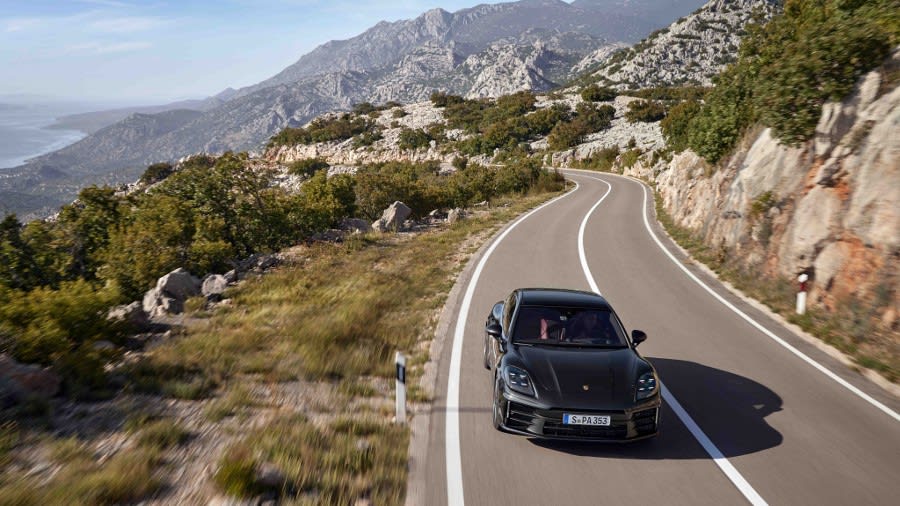
Verdict & Next Steps
Unsurprisingly, the Panamera remains the gold standard for cars of this ilk. It never ceases to amaze that Porsche can get it right so consistently, making a big, four-door luxury car feel like a sports coupe. Yes, the outgoing Panamera was brilliant, but the new model is brilliant too, and it comes with a few extra tech gizmos that make it worth the upgrade. For those who choose the plug-in hybrid powertrain, that bigger battery and more powerful motor will make a world of difference, too, and ensure the Panamera E-Hybrid remains the luxury hybrid saloon of choice
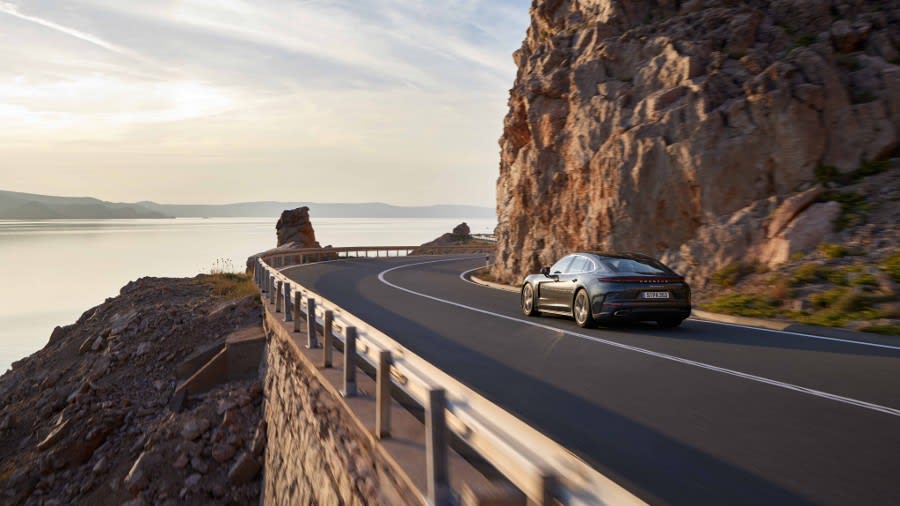
Where to next?
View latest Porsche Panamera hatchback/saloon lease deals - from £1,079 per month inc VAT**.
Call us on 0118 3048 688 or hit the green 'Enquire' button for more details.
Looking for a great leasing deal? Check out our incredible range of Special Offers and Lease Deals.
New Saloon? Read our latest Reviews and find the right model for you.
Want to know more about leasing? Take a look at our comprehensive Leasing Guides.
Interested in everything motoring? Why not catch up on all the latest Car Leasing News.
**Score based on Select’s unique meta score analysis, taking into account the UK’s top leading independent car website reviews of the Porsche Panamera.
**Correct as of 08/04/2024. Based on 9 months initial payment, 5,000 miles annually, over a 48 month lease. Initial payment equivalent to 9 monthly payments, or £9,713.43 (Plus admin fee) Ts and Cs apply. Credit is subject to status.
